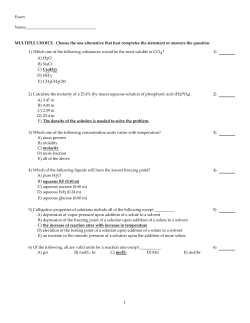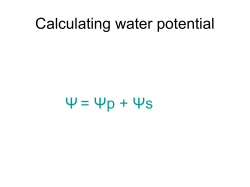
Name chemistry Unit 8 worksheet 1. Why do
Name ___________________________________________period______________AP chemistry Unit 8 worksheet 1. Why do ionic substances with higher lattice energies tend to be less soluble in water than those with lower lattice energies? Like dissolves like. Ionic substances with high lattice energies have stronger ionic bonds which gets more unlike polar water 2. Which of the following solutes would you predict to dissolve in water a. KCl b. CH4 c. NH3 d. Cu 3. Which of the following solutes would you predict to dissolve in a toluene (nonpolar) a. NaCl b. CH4 c. NH3 4. For each solute listed, select a solvent that will dissolve it. Solute Solvent Sodium (mercury) water Gasoline (benzene) mercury KCl (water) benzene NH3 (polar) (water) 5. Explain why glycerol (CH2(OH)CH (OH)CH2(OH)) is miscible in water. It is polar like water (hydrogen bonds) 6. Which of the following in each pair is likely to be more soluble in water? Explain a. CH3CH2CH2CH2OH or CH3CH2OH b. CCl4 or CaCl2 c. benzene or phenol(C6H5OH) 7. a. Explain why carbonated beverages must be stored in sealed containers. So the gas (CO2) doesn’t escape b. Once the beverage is opened, why does it maintain some carbonation when refrigerated? Colder temperature make gas more soluble 8. a. What is a saturated solution? Solvent is holding the maximum amount of solute (solute and solvent are at equilibrium) b. what visible evidence indicates that a solution is saturated? Undissolved Solute settles to the bottom c. what is an unsaturated solution? Solvent is holding less solute than it can hold d. What is a supersaturated solution? Solvent is dissolving more solute than it can hold 9. Calculate the molarity of 10.5 g of KCl in 250.0 mL of solution. 0.563 M 10. Calculate the molarity of 25.0 mL of 1.50M HNO3 solution diluted to 0.500 L. 0.0750 M 11. Calculate the moles of solute in each of the following 335 mL of 0.215 M calcium bromide 0.0763 mol a. 5.13 g KBr in 255 g of water 100.17 ⁰C; -0.63 ⁰C 12. What is meant by the term reaction rate? The change in the amount of products or reactants in a given amount of time 13. For each of the following pairs, choose the substance or process you would expect to react more rapidly. a. Granulated sugar or powdered sugar b. Zinc in HCl at 298 K or zinc in HCl at 410 K c. 5 g of thick platinum wire or 5 g of thin platinum wire 14. The heat of solution for silver nitrate is +22.8 kJ/mol. The solubility of silver nitrate is 216 g per 100 g of water at 30 °C a. Is heat a reactant or a product? reactant b. Is dissolving silver nitrate endothermic or exothermic? endothermic c. As silver nitrate dissolves, what change occurs in the temperature of the solution? decreases d. How will increased temperature affect the amount of solute that can be dissolved? More will dissolve e. How would increased temperature affect how fast the solute dissolved? Speeds it up f. How would stirring the solution affect the amount of solute that can be dissolved? Doesn’t change g. How would stirring the solution affect how fast the solute dissolved? Speeds it up h. If 100 g of silver nitrate is added to 100 g of water at 30 °C, would the solution be unsaturated, saturated, or supersaturated? unsaturated i. What would occur if 325 g are added to 100 g of water at 30 °C? Is the solution unsaturated, saturated, or supersaturated? saturated 15. For each energy diagram below, label reactants, products, ∆H, Ea, and tell if it is endothermic or exothermic. 16. How would each of the energy diagrams in the previous problem change if a catalyst were added to the reaction? (show using dashed lines) 17. Would you expect a packet of sugar to dissolve faster in hot tea or iced tea? Hot tea 18. Consider the hypothetical reaction A B. A flask is charged with 0.65 mol of A in a total volume of 100.0 mL. The following data is collected Time(min) 0 10 20 30 40 Moles of A 0.065 0.051 0.042 0.036 0.031 Moles of B 0.00 0.014 0.023 0.029 0.034 Rate if disappearance(mol/s) 2.3 x10-5 1.5x 10-5 1.0x10-5 0.8x10-5 a. Calculate the number of moles of B at each time in the table b. Calculate the average rate of disappearance of A for each 10 min interval in units of mol/s c. Why does the rate change for each 10 min. interval? The reactants are becoming less concentrated as the reaction proceeds so the reaction slows down d. Calculate the rate of appearance of B in M/s from 10-30 min. 1.3x10-5 M/s 19. Consider the combustion of H2(g): 2H2(g) + O2(g) 2H2O(g) a. If hydrogen is burning at a rate of 4.6 mol s-1, what is the rate of consumption of oxygen? 2.3 mol s-1 b. What is the rate of the formation of water vapor? 4.6 mol/s 20. The reaction 2NO(g) + Cl2(g) 2NOCl(g) is carried out in a closed vessel. If the partial pressure of NO is decreasing at the rate of 30 torr/min., what is the rate of change of the total pressure of the vessel? Decreases by 15 torr/min 21. For the reaction 3 ClO – (aq) → ClO3 – (aq) + 2 Cl – (aq) doubling the concentration of ClO – quadruples the initial rate of formation of ClO3-. What is the rate law expression for the reaction? Rate = k[ClO-]2 22. The reaction C6H5N2Cl (aq) + H2O (l) → C6H5OH (aq) + N2 (g) + HCl (aq) is first order in C6H5N2Cl and zero order in H2O. What is the rate law expression? Rate = k[C6H5N2Cl] 23. For the reaction 2 NO (g) + Cl2 (g) → 2 NOCl (g) If the concentration of NO is tripled, the rate of the reaction increases by a factor of nine. If the concentration of Cl2 is cut in half, the rate of the reaction is decreased to half the original rate. Find the order of reaction for each reactant and write the rate law expression for the reaction. NO is second order and chlorine is first order; Rate = k[NO]2[Cl2] 24. A reaction has the experimental rate law of Rate = k[A]2. What happens to the rate if the concentration of A is tripled? Increases by nine times 25. For the reaction 2 A + B → C + D, if the concentration of A is doubled, the reaction rate doubles. If the concentration of B is halved, there is no change in the reaction rate. Determine the order of reaction with respect to each reactant and the overall order of reaction. Write the rate law for the reaction. A is first order and B is zero order; the overall order is 1; rate = k[A] 26. Consider the reaction A + 2B C. The rate law for this reaction is second order in A and second order in B. If the rate constant at 25 C is 1.25 x 10-2 M-3s-1 , find the rate of reaction when the concentration of A is 0.27 M and the concentration of B is 0.32 M. 9.3 x 10-5 M/s 27-29: For each of the following sets of data, support your reasoning mathematically. 27. For the reaction A + B AB , the following data were obtained. Trial Initial [A] Initial [B] Initial Rate (mol/L•s) 1 0.720 M 0.180 M 0.470 2 0.720 M 0.720 M 1.880 3 0.360 M 0.180 M 0.117 a) Determine the order with respect to each reactant A is second order, B is first order b) Determine the overall order of reaction 3 c) Write the rate law for the reaction. Rate = k[A]2[B] d) Find the value (including units) of the rate constant, k. 5.04 M-2S-1 28. For the reaction 2A + B A2B , the following data were obtained. Trial Initial [A] Initial [B] Initial Rate of appearance of A2B (mol/L•s) 1 0.420 M 0.530 M 0.420 2 0.420 M 1.590 M 3.780 3 0.140 M 0.530 M 0.140 a) Determine the order with respect to each reactant A is first order; B is second order b) Determine the overall order of reaction 3 c) Write the rate expression for the reaction. Rate = k[A][B]2 d) Find the value (including units) of the rate constant, k. 3.56 M-2s-1 e) What is the rate of disappearance of A, when [A] = 0.074 M and [B] = 0.185 M? 0.018 M/s 29. For the reaction 2A + B2 AB , the following data were obtained. Trial Initial [A] Initial [B] Initial Rate (M/s) 1 0.300 M 0.430 M 0.340 2 0.300 M 1.720 M 1.360 3 0.150 M 0.430 M 0.340 a) Determine the order with respect to each reactant zero order for A and first order for B b) Determine the overall order of reaction 1 c) Write the rate expression for the reaction. Rate = k[B] d) Find the value (including units) of the rate constant, k. 0.791 s-1 30. The reaction between chloroform and chlorine gas proceeds in a series of three elementary steps. Step 1: Fast, reversible Cl2(g) 2Cl(g) Step 2: Slow CHCl3(g) + Cl(g) CCl3(g) + HCl(g) Step 3: Fast CCl3(g) + Cl(g) CCl4(g) Overall reaction: CHCl3(g) + Cl2(g) CCl4(g) + HCl(g) (a) Which of the steps in the rate determining step? Step 2 (b) Write the rate expression for the rate determining step. Rate = k[CHCl3][Cl] 31. At temperatures less than 500 K the reaction between carbon monoxide and nitrogen dioxide CO(g) + NO2(g) CO2(g) + NO(g) follows the rate expression “Rate = k[NO2]2.” Which of the three mechanisms suggested below agrees with the experimentally observed rate expression? Mechanism I: NO2 + CO CO2 + NO Mechanism II: NO2 + NO2 NO3 + NO slow NO3 + CO NO2 + CO2 fast Mechanism III: NO2 NO + O slow CO + O CO2 fast 32. For the reaction between hydrogen and iodine: H2(g) + I2(g) 2HI(g) Given the following mechanism, write the rate law for the reaction rate = k[H2][I2] Step 1: I2(g) 2I(g) fast Step 2: H2(g) + I(g) + I(g) 2HI(g) slow 33. NO2 NO + ½ O2 is studied at 383 °C, giving the following data Time(s) [NO2] (M) 0.00 0.100 5.0 0.017 10.0 0.0090 15.0 0.0062 20.0 0.0047 a. is the reaction first order or second order with respect to the concentration of NO2? Second order b. What is the value of the rate constant? 10 M-1s-1 Review: 34. Write a balanced net ionic reaction a. i. Solid Ammonium carbonate decomposes as it is heated (NH4)2CO3 2NH3 + CO2 + H2O ii. Predict the algebraically sign of ∆S for the reaction. Explain your reasoning Positive; because a solid is forming a gas (more disorder) b. i. chlorine gas is bubbled into a solution of potassium bromide Cl2 + 2Br- Br2 +2 Clc. i. A small piece of sodium is added to a beaker of distilled water. Na + 2H2O Na++ 2OH- + H2 ii. The reaction is exothermic and sometimes a small flame is observed as the sodium reacts. Identify the product of the reaction that burns to produce the flames. Hydrogen gas 35. [Xe]6s25d104f146p2 36. a,c,d
© Copyright 2025





















